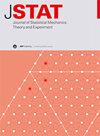Independent-oscillator model and the quantum Langevin equation for an oscillator: a review
IF 1.9
3区 物理与天体物理
Q2 MECHANICS
Journal of Statistical Mechanics: Theory and Experiment
Pub Date : 2024-07-15
DOI:10.1088/1742-5468/ad5711
引用次数: 0
Abstract
This review provides a brief and quick introduction to the quantum Langevin equation for an oscillator, while focusing on the steady-state thermodynamic aspects. A derivation of the quantum Langevin equation is carefully outlined based on the microscopic model of the heat bath as a collection of a large number of independent quantum oscillators, the so-called independent-oscillator model. This is followed by a discussion on the relevant ‘weak-coupling’ limit. In the steady state, we analyze the quantum counterpart of energy equipartition theorem which has generated a considerable amount of interest in recent literature. The free energy, entropy, specific heat, and third law of thermodynamics are discussed for one-dimensional quantum Brownian motion in a harmonic well. Following this, we explore some aspects of dissipative diamagnetism in the context of quantum Brownian oscillators, emphasizing upon the role of confining potentials and also upon the environment-induced classical-quantum crossover. We discuss situations where the system-bath coupling is via the momentum variables by focusing on a gauge-invariant model of momentum-momentum coupling in the presence of a vector potential; for this problem, we derive the quantum Langevin equation and discuss quantum thermodynamic functions. Finally, the topic of fluctuation theorems is discussed (albeit, briefly) in the context of classical and quantum cyclotron motion of a particle coupled to a heat bath.振荡器的独立振荡器模型和量子朗文方程:综述
这篇综述简要而快速地介绍了振荡器的量子朗格文方程,同时侧重于稳态热力学方面。在将热浴作为大量独立量子振荡器集合的微观模型(即所谓的独立振荡器模型)的基础上,仔细概述了量子朗温方程的推导。随后讨论了相关的 "弱耦合 "极限。在稳态下,我们分析了能量等分定理的量子对应理论,该理论在最近的文献中引起了相当大的兴趣。我们讨论了谐波井中一维量子布朗运动的自由能、熵、比热和热力学第三定律。随后,我们在量子布朗振荡器的背景下探讨了耗散二磁性的某些方面,强调了约束势的作用以及环境诱导的经典-量子交叉。我们讨论了系统-水浴耦合是通过动量变量实现的情况,重点是存在矢量势时动量-动量耦合的规整不变模型;对于这个问题,我们推导了量子朗格文方程,并讨论了量子热力学函数。最后,我们结合与热浴耦合的粒子的经典和量子回旋运动,讨论了波动定理(尽管很简短)。
本文章由计算机程序翻译,如有差异,请以英文原文为准。
求助全文
约1分钟内获得全文
求助全文
来源期刊
CiteScore
4.50
自引率
12.50%
发文量
210
审稿时长
1.0 months
期刊介绍:
JSTAT is targeted to a broad community interested in different aspects of statistical physics, which are roughly defined by the fields represented in the conferences called ''Statistical Physics''. Submissions from experimentalists working on all the topics which have some ''connection to statistical physics are also strongly encouraged.
The journal covers different topics which correspond to the following keyword sections.
1. Quantum statistical physics, condensed matter, integrable systems
Scientific Directors: Eduardo Fradkin and Giuseppe Mussardo
2. Classical statistical mechanics, equilibrium and non-equilibrium
Scientific Directors: David Mukamel, Matteo Marsili and Giuseppe Mussardo
3. Disordered systems, classical and quantum
Scientific Directors: Eduardo Fradkin and Riccardo Zecchina
4. Interdisciplinary statistical mechanics
Scientific Directors: Matteo Marsili and Riccardo Zecchina
5. Biological modelling and information
Scientific Directors: Matteo Marsili, William Bialek and Riccardo Zecchina

 求助内容:
求助内容: 应助结果提醒方式:
应助结果提醒方式:


